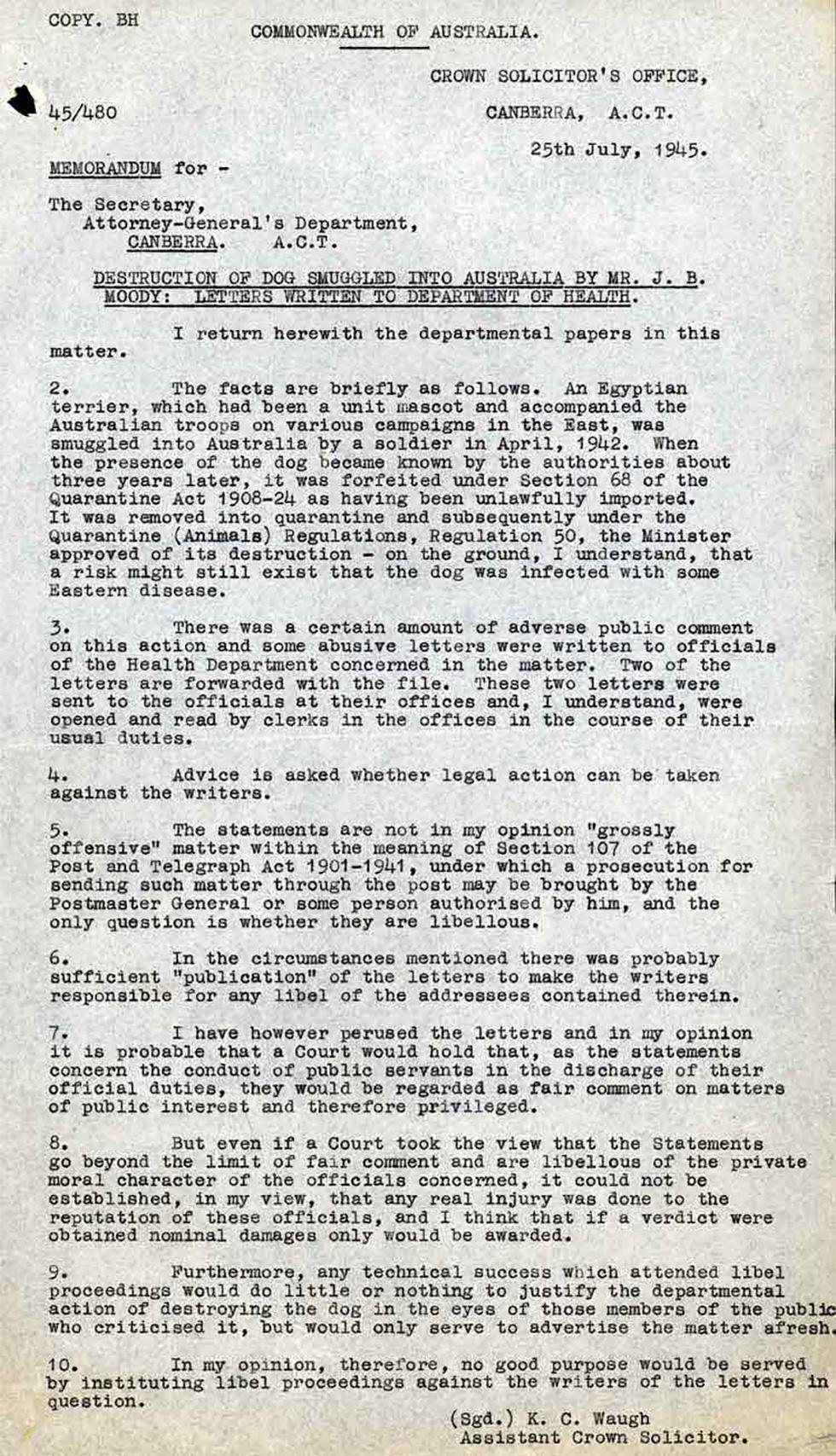
Memo for the Secretary, Attorney-General's Department, regarding the destruction of a smuggled dog.
Aboriginal and Torres Strait Islander people should be aware that the National Archives' website and collection contain the names, images and voices of people who have died.
Some records include terms and views that are not appropriate today. They reflect the period in which they were created and are not the views of the National Archives.


Memo for the Secretary, Attorney-General's Department, regarding the destruction of a smuggled dog.
COPY. BH
COMMONWEALTH OF AUSTRALIA.
[Dividing line.]
CROWN SOLICITOR'S OFFICE,
CANBERRA, A.C.T.
25 th July, 1945.
[Tear at side of page.]
45/480
[Word underlined] MEMORANDUM for –
The Secretary,
Attorney-General's Department,
[Word underlined] CANBERRA. A.C.T.
[Underlined] DESTRUCTION OF DOG SMUGGLED INTO AUSTRALIA BY MR. J. B. MOODY: LETTERS WRITTEN TO DEPARTMENT OF HEALTH.
I return herewith the departmental papers in this matter.
2. The facts are briefly as follows. An Egyptian terrier, which had been a unit mascot and accompanied the Australian troops on various campaigns in the East, was smuggled into Australia by a soldier in April, 1942. When the presence of the dog became known by the authorities about three years later, it was forfeited under Section 68 of the Quarantine Act 1908-24 as having been unlawfully imported. It was removed into quarantine and subsequently under the Quarantine (Animals) Regulations, Regulation 50, the Minister approved of its destruction – on the ground, I understand, that a risk might still exist that the dog was infected with some Eastern disease.
3. There was a certain amount of adverse public comment on this action and some abusive letters were written to officials of the Health Department concerned in the matter. Two of the letters are forwarded with the file. These two letters were sent to the officials at their offices and, I understand, were opened and read by clerks in the offices in the course of their usual duties.
4. Advice is asked whether legal action can be taken against the writers.
5. The statements are not in my opinion "grossly offensive" matter within the meaning of Section 107 of the Post and Telegraph Act 1901-1941, under which a prosecution for sending such matter through the post may be brought by the Postmaster General or some person authorised by him, and the only question is whether they are libellous.
6. In the circumstances mentioned there was probably sufficient "publication" of the letters to make the writers responsible for any libel of the addressees contained therein.
7. I have however perused the letters and in my opinion it is probable that a Court would hold that, as the statements concern the conduct of public servants in the discharge of their official duties, they would be regarded as fair comment on matters of public interest and therefore privileged.
8. But even if a Court took the view that the statements go beyond the limit of fair comment and are libellous of the private moral character of the officials concerned, it could not be established, in my view, that any real injury was done to the reputation of these officials, and I think that if a verdict were obtained nominal damages only would be awarded.
9. Furthermore, any technical success which attended libel proceedings would do little or nothing to justify the departmental action of destroying the dog in the eyes of those members of the public who criticised it, but would only serve to advertise the matter afresh.
10. In my opinion, therefore, no good purpose would be served by instituting libel proceedings against the writers of the letters in question.
(Sgd.) K. C. Waugh
Assistant Crown Solicitor.
Learn how to interpret primary sources, use our collection and more.
